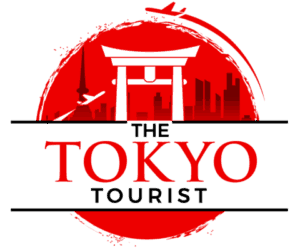Deprecated: mb_convert_encoding(): Handling HTML entities via mbstring is deprecated; use htmlspecialchars, htmlentities, or mb_encode_numericentity/mb_decode_numericentity instead in /home2/thetoky7/public_html/wp-content/themes/acabado/functions.php on line 2119
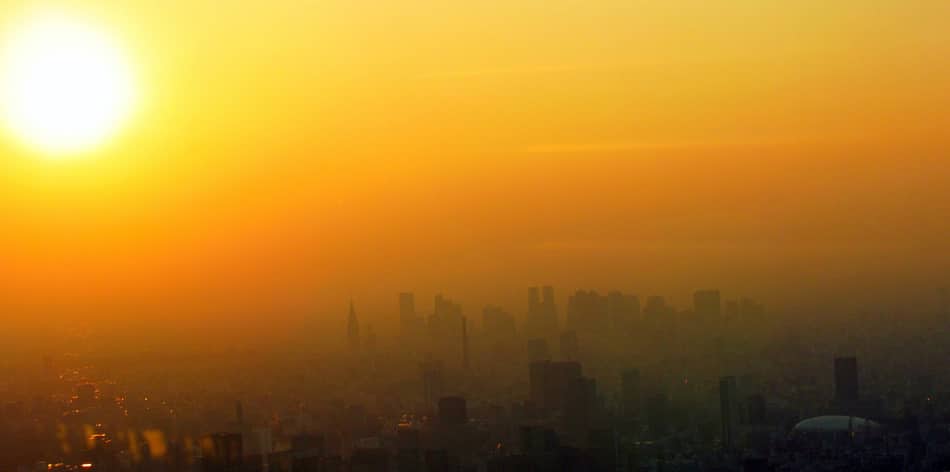
This is a rather broad question. First of all, what kind of pollution are we talking about? Light pollution? Noise pollution? Water pollution? Air pollution? I’m guessing you’re most concerned about the latter. I’m going to touch on the different types of pollutions and see how Tokyo compares to other big cities. But first, let’s have a look at the air pollution.
Is Tokyo polluted? To be frank, this is not an easy yes or no question, but if I were to give you a quick and dirty answer it would be: No, compared to other big cities Tokyo is not especially polluted. Tokyo’s annual mean of dangerous PM2.5 particles is 15 micrograms/m3 whereas the European Union’s emission standards state an annual mean of 25 micrograms/m3 as an upper limit.
What is Pollution?
The definition of pollution is the “presence in or introduction into the environment of a substance which has harmful or poisonous effects.” So what are some of these substances? And where in the environment can you find them? When you hear about pollution, you might picture exhaust fumes, littering, or oil spills. But there are other kinds of pollution you might not know: Noise and light pollution. My main focus will be on the more “traditional” kind of pollution, but both noise and light pollution is certainly worth mentioning as it’s very relevant to Tokyo.
If you’re here just to read and learn about air pollution you can click here!
Noise pollution
Noise pollution or noise disturbance is the disturbing or excessive noise that may harm the activity or balance of human or animal life. The source of most outdoor noise is mainly from machines and transportation like cars, trains, and planes.
How’s it like in Tokyo? To be honest, depending on where you are, it can be pretty extreme. But what are the sources? I still remember my first times to Tokyo and the shock I got. From what? From the blaring billboards and television screens, the insane gaming halls, the trucks driving around touting their messages and from malls full of employees with megaphones… This is very different from what I’m used to!
Especially the billboards and television screens took me by surprise. It’s so strange to stand at the world famous Shibuya crossing and see ten colossal billboard screens all competing for your attention. And how do they do it? With bright colors, flashing lights and loud sounds. Check out the video below to get a small taste of what I’m talking about.
Light pollution
Speaking of bright colors and flashing lights. There are studies showing that exposure to artificial light at night can harm your health. We’re obviously not talking about a little exposure here and there, but the persistent exposure that suppresses melatonin production and messes with your circadian rhythms. This shouldn’t be a problem for tourists. Just remember to draw the curtains before you go to bed if your hotel is centrally located!
The Light can trick you!
I remember one time I got to Tokyo, all jet-lagged from a 13-hour flight. Because I’d traveled across time zones (west to east) I “lost” quite a few hours. Anyway, I got to my hotel around 11 p.m., and I felt dead tired. There was only one problem: I wanted to see a football match (soccer) from England that started at 1 a.m. Tokyo time. I found the nearest sports bar and had a beer and some nuts and waited for the game to start. I got energy from the lively atmosphere at the bar, and when the game kicked off, I was no longer tired.
Why am I telling you this? Well, the point is at some point during the game I got lulled into the belief that it was daytime. I’m sure the jet-leg played some part in it, but I think the main reason for my confusion was the windows. My bar was on the 1st floor and had windows towards a busy street in downtown Shibuya. And when you look out the window, it’s impossible to distinguish night from day because the streets are so brightly lit with strong fluorescent lights. So there I was, watching football in the middle of the night, seeing “daylight” in the corner of my eye, and thus my brain got tricked into believing it was 3 p.m. when it was 3 a.m.
Some parts of Tokyo are really bright!
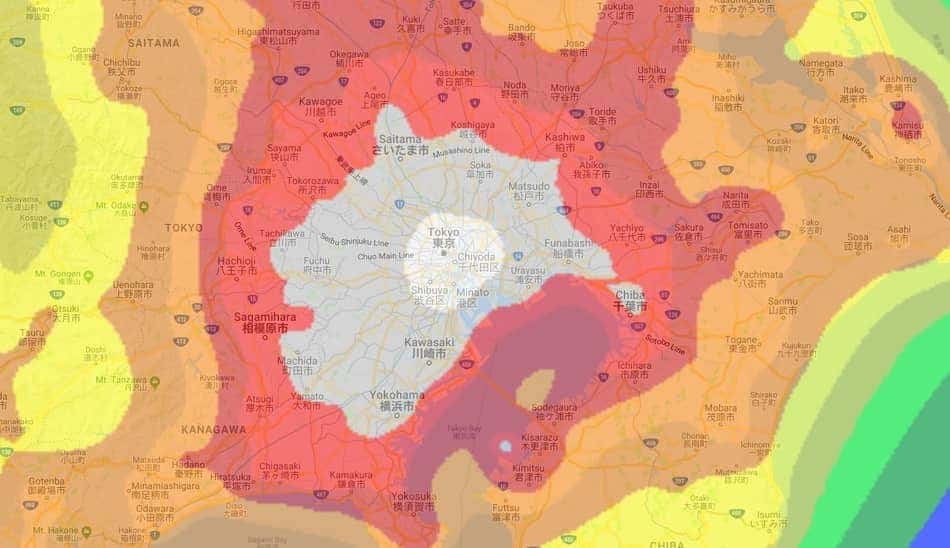
Water pollution
Let me start off saying that the tap water in Tokyo is completely safe. No question about it. But what about the ponds and rivers? And what about Tokyo Bay?
Ponds, lakes, and rivers
There are about 120 rivers of various sizes flowing through Tokyo and well over 100 ponds and lakes. Due to poor water quality, it’s not advised to swim in the rivers nor the ponds and lakes.
Tokyo Bay
A ban on swimming at beaches in the Tokyo metropolitan area was put into effect in the 1960s due to deterioration in water quality. This ban lasted until 2015 where a beach in Kasai Kaihin Park was opened for the public. The beach allows for summer swimming depending on the water quality. The area around Tokyo bay is heavily industrialized, and therefore the water quality is poor.
Air Pollution
According to the 2014 World Health Organization report, air pollution caused the deaths of around 7 million people worldwide in 2012. This is obviously no small problem. But what is air pollution? And how do you measure it?
According to whataboutpollution.com the most harmful pollutant to human health is particle pollution. We usually call it “soot.”
What is Particle Pollution?
This type of pollutant consists of tiny liquid and solid particles in the air we breathe. These particles typically come from exhaust smoke. The most dangerous form of particles are the smallest ones because they can penetrate deep into the lungs and even into the bloodstream.
Science alert! These particles are therefore categorized after its size with PM2.5 being the smallest category. PM is short for Particulate Matter and 2.5 means 2.5 microns or less. So when we, for example, say a “PM2.5 of 30” it means 30 micrograms (µg) of particles with a size of 2.5 microns or less per cubic meter (m3). And how small are particles with the size of 2.5 microns? It’s 20-30 times smaller than the diameter of human hair.
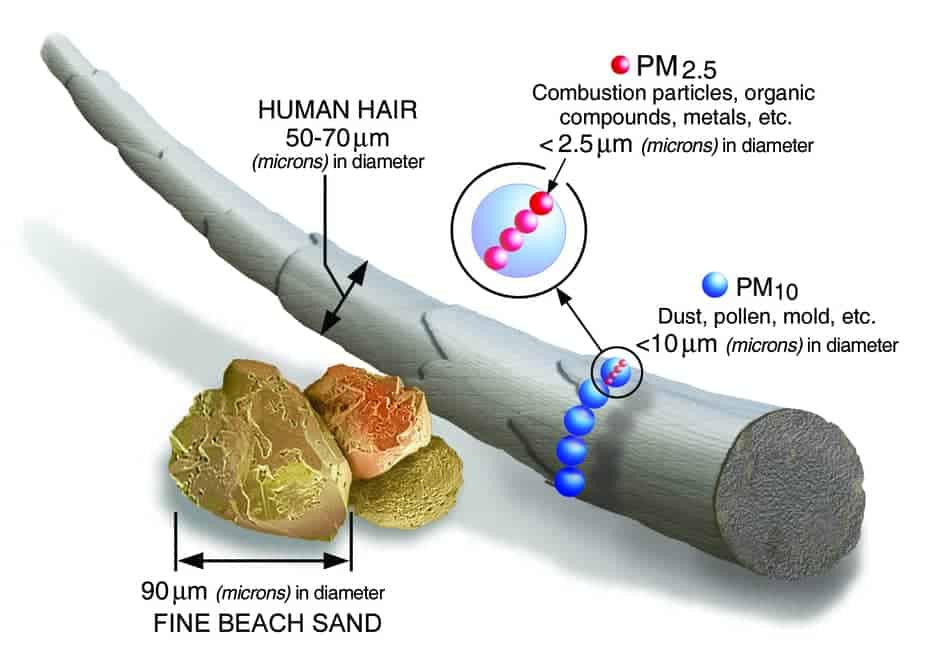
WHO Guidelines
The World Health Organization’s guidelines stipulate that the amount of PM2.5 particles should not exceed 10 μg/m3. They admit that this is extremely stringent, but they use 10 μg/m3 in their guidelines to protect people with asthma and severe respiratory diseases. Levels above 10 μg/m3 are not necessarily harmful to most people but can be cumbersome if you, for example, have asthma.
“…it is unlikely that any standard or guideline value will lead to complete protection for every individual against all possible adverse health effects of particulate matter. Rather, the standard-setting process needs to aim at achieving the lowest concentrations possible in the context of local constraints, capabilities and public health priorities.” Source: WHO
98% of cities in low- and middle-income countries with more than 100 000 inhabitants do not meet WHO air quality guidelines. However, in high-income countries, that percentage decreases to 56%.
Different Regulations in Different Countries
Okay, so according to the WHO, the exposure to PM2.5 should not exceed an annual mean of 10 μg/m3. But what are the regulations in some major countries?
Set limits for particulates in the air (μg/m3):
- China – 35
- Hong Kong – 35
- European Union – 25
- Japan – 15
- South Korea – 15
- United States – 12
- Canada – 10
- Australia – 8
These are the set limit and as you can see Japan is in the middle of the pack with a limit of 15 μg/m3 as an annual mean. It’s above the WHO guideline, but below the European Union’s regulations.
Set limits and regulations are one thing, but results are an entirely different thing. So, how is the actual pollution in Tokyo?
Here are the stats from 2016 from major cities in Asia. The source is The Guardian. You can check out the complete report from the World Health Organization here. (Excel worksheet)
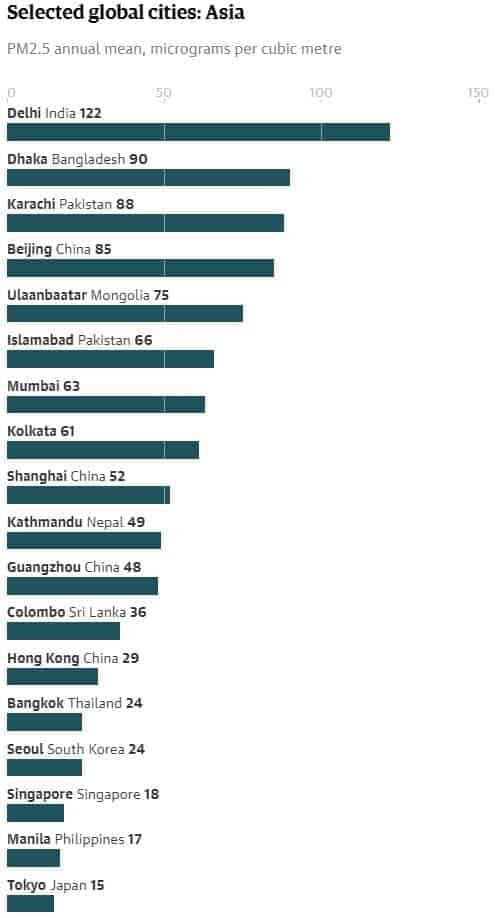
Some other major cities in other parts of the world:
- Istanbul – 33
- Mexico City – 20
- Paris – 18
- Rome – 17
- London – 15
- Los Angeles – 11
- New York – 9
- Sydney – 8
- Toronto – 8
Pollution in General
What if you take a comprehensive look at all aspects of pollution to get a real feel for how it is to stay and live in Tokyo? Numbeo.com have their own pollution index where they list many variables and assign them different weight according to their importance.
These are their criteria:
- Air Pollution
- Drinking Water Pollution and Inaccessibility
- Dissatisfaction with Garbage Disposal
- Dirty and Untidy
- Noise and Light Pollution
- Water Pollution
- Dissatisfaction to Spend Time in the City
- Dissatisfaction with Green and Parks in the City

The World’s Largest Cities
On this scale, lower is better. How does Tokyo compare to the cities with the largest metropolitan areas in the world? This is the top 10:
| City | Pollution Index |
| Tokyo | 44.69 |
| Nanjing | No data |
| Jakarta | 81.81 |
| Guangzhou | 84.66 |
| Beijing | 89.67 |
| Shanghai | 83.40 |
| Sao Paulo | 82.87 |
| Lagos | No data |
| Mexico City | 84.11 |
| New York | 57.87 |
Other Major Cities in the World
| City | Pollution Index |
| Stockholm | 16.62 |
| Sydney | 29.34 |
| Cape Town | 38.25 |
| Washington DC | 39.05 |
| Melbourne | 45.38 |
| Madrid | 56.19 |
| Los Angeles | 60.03 |
| London | 60.18 |
| Paris | 65.92 |
| Chicago | 67.18 |
| Istanbul | 69.73 |
| Berlin | 69.81 |
| Delhi | 91.25 |
Conclusion
So is Tokyo polluted? It’s certainly not perfect, but the amount of pollution is moderate. Tokyo can’t compete with the likes of Boulder in Colorado, but when you take into account that Tokyo has the largest metropolitan area in the world and that people = pollution, it’s more than OK. Are you worried about the pollution in Tokyo? Leave a comment down below.
PS: Worried about radiation in Japan and Tokyo? You shouldn’t be.
